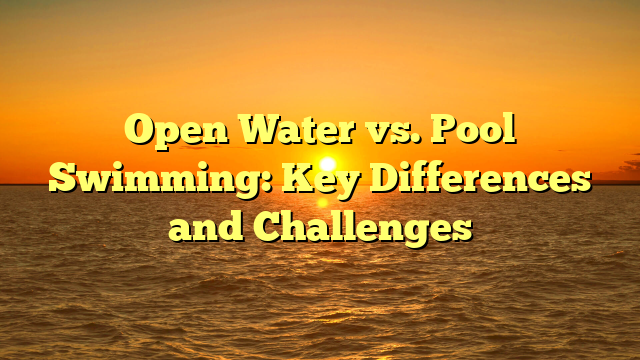
Swimming can take place in a variety of environments, but the two primary forms are pool swimming and open water swimming. While both require endurance, technique, and speed, they differ significantly in conditions, strategies, and challenges.
In this article, we’ll explore the major differences between open water and pool swimming, the unique challenges of each, and how swimmers can prepare for both.
1. The Key Differences Between Open Water and Pool Swimming
2. The Unique Challenges of Open Water Swimming
Open water swimming presents a variety of obstacles that swimmers must prepare for:
1. Unpredictable Water Conditions
✔ Unlike pools, open water has waves, currents, and tides that can affect speed and stamina.
✔ Swimmers must adjust their stroke and breathing to handle rough water.
2. Navigation and Sighting
✔ Without lane lines, swimmers must use landmarks or buoys to stay on course.
✔ Effective sighting techniques help prevent zigzagging, which wastes energy.
3. Temperature Fluctuations
✔ Water temperatures vary, sometimes dropping below 15°C (59°F).
✔ Cold water can cause muscle fatigue and hypothermia, requiring acclimatization.
4. Marine Life and Hazards
✔ Swimmers may encounter fish, jellyfish, seaweed, or even large marine animals.
✔ In slot 4d or lakes, debris and underwater obstacles can pose risks.
5. No Flip Turns or Resting Walls
✔ Unlike pools, open water swimmers can’t rely on push-offs from walls.
✔ Races require continuous swimming, demanding greater endurance.
3. The Unique Challenges of Pool Swimming
Pool swimming has its own competitive challenges that require precision and technique:
1. Flip Turns and Push-Offs
✔ Competitive swimmers must master flip turns, which save time in races.
✔ Poor push-offs can lead to lost momentum and slower lap times.
2. Strict Race Regulations
✔ Pools have rigid rules for turns, starts, and finishes.
✔ Swimmers must follow specific stroke techniques to avoid disqualification.
3. Intense Sprinting and Race Strategies
✔ Pool races are often faster and more explosive, requiring quick reaction times.
✔ Swimmers need perfect stroke efficiency to reduce drag and increase speed.
4. How Swimmers Can Transition Between Open Water and Pool Swimming
✔ Pool Swimmers Moving to Open Water:
Train in lakes or oceans to get used to unpredictable conditions.
Practice sighting techniques to swim in a straight line.
Get used to longer distances without walls.
✔ Open Water Swimmers Moving to Pools:
Work on flip turns and push-offs to improve speed.
Focus on stroke efficiency and precise techniques.
Adapt to faster sprint paces instead of endurance-based swimming.
5. Conclusion
Both open water and pool swimming require unique skills and strategies. While pool swimming focuses on speed, precision, and turns, open water swimming demands endurance, navigation, and adaptability. Swimmers who can master both environments become versatile, well-rounded athletes capable of excelling in any setting.



